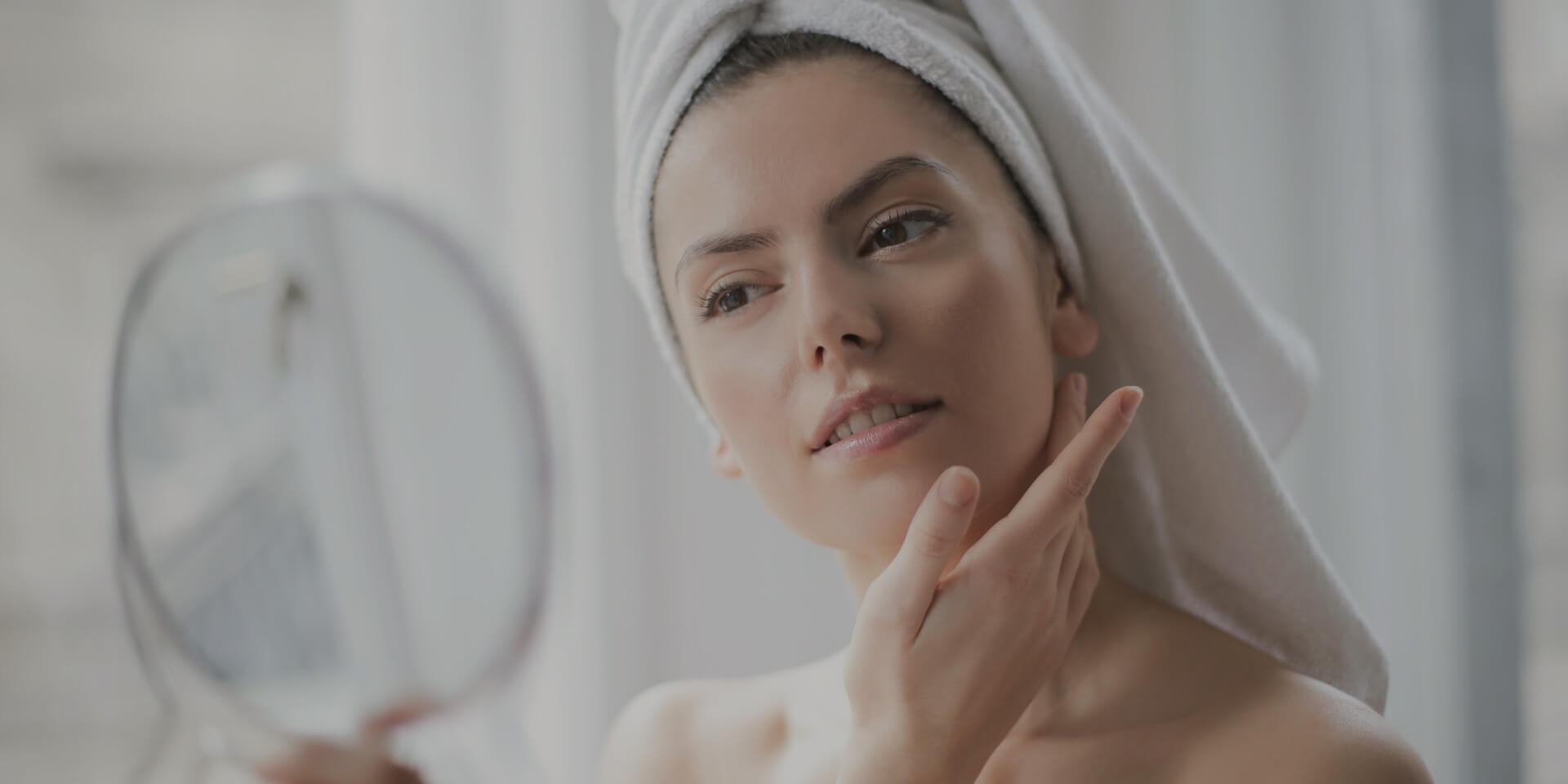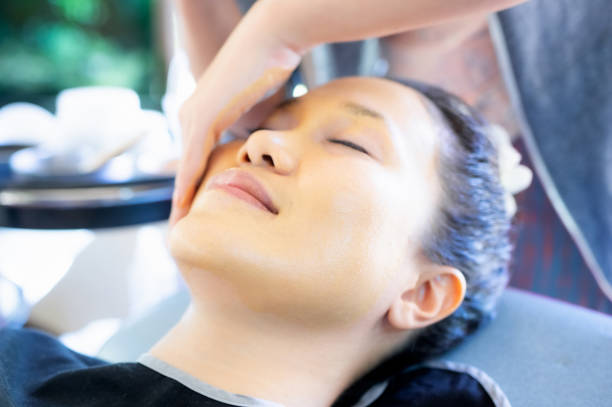
10 Morning Habits That Guarantee a Good Skin
Morning Habits That Guarantee a Good Skin Having beautiful and radiant skin is something many people desire. While there are numerous skincare products on the market, achieving healthy skin begins with adopting the right morning habits. In this article, we will explore ten-morning habits that are guaranteed to promote good skin and help you achieve a glowing complexion.
1. Start with a Glass of Water

- Upon waking up, one of the best things you can do for your body and skin is to start your day with a refreshing glass of water. After hours of sleep, your body becomes dehydrated, and drinking water in the morning helps rehydrate and kickstart your system.
- Water is essential for maintaining the elasticity and suppleness of your skin. When you’re adequately hydrated, your skin looks plump and radiant, and it also helps flush out toxins from your body, contributing to a clearer complexion.
- Make it a habit to reach for a glass of water first thing in the morning, and you’ll notice the difference it makes in your skin’s appearance and overall well-being. To add a healthy twist, you can even squeeze some fresh lemon juice into the water for an extra boost of vitamin C, which further supports skin health.
2. Cleanse Gently

- In the morning, gently cleansing your face is an essential step in your skincare routine. Cleansing helps remove any sweat, oil, or impurities that may have accumulated on your skin while you are asleep.
- When choosing a cleanser, opt for one that is suitable for your skin type and is gentle on the skin. Avoid harsh cleansers or soaps, as they can strip your skin of its natural oils, leading to dryness and irritation.
- To cleanse your face, start by wetting it with lukewarm water. Take a small amount of cleanser in your palm and lather it up. Gently massage the cleanser onto your face using circular motions, paying attention to your forehead, nose, cheeks, and chin. Be sure to avoid the delicate area around your eyes.
- After massaging the cleanser for about 30 seconds, rinse your face thoroughly with water. Pat your skin dry with a soft, clean towel.
- Cleansing your face in the morning not only refreshes your skin but also prepares it for the next steps in your skincare routine. It allows better absorption of the products you apply afterwards, such as toners, serums, and moisturizers.
- By making gentle cleansing a part of your morning habits, you can maintain a clean and healthy complexion, setting the foundation for glowing skin throughout the day.
3. Use a Nourishing Toner

- After cleansing your face, the next step in your morning skincare routine is to use a nourishing toner. Toning is a crucial step that helps balance your skin’s pH levels, tighten pores, and provide additional hydration.
- Choose a toner that suits your skin type and contains nourishing ingredients. Natural toners with ingredients like rosewater, witch hazel, or chamomile are excellent choices as they soothe and replenish the skin without irritating.
- To apply the toner, take a small amount on a cotton pad or use clean hands to gently pat it onto your face and neck. Avoid rubbing or pulling on the skin to prevent unnecessary stretching.
- Nourishing toners play a vital role in preparing your skin to absorb the subsequent skincare products more effectively. By keeping your skin’s pH balanced and hydrated, toners help enhance the overall health and appearance of your skin.
- Using a nourishing toner in the morning is especially beneficial if you have dry or sensitive skin, as it provides an extra layer of moisture and protection against environmental factors. It also primes your skin for the application of serums and moisturizers, maximizing their benefits throughout the day.
- Make using a nourishing toner a part of your morning skincare ritual, and you’ll notice your skin feeling refreshed, toned, and ready to take on the day.
4. Apply Vitamin C Serum

- Before we dive into the nitty-gritty of Vitamin C serum application, let’s cover the basics. Vitamin C, also known as ascorbic acid, is a water-soluble antioxidant that helps protect the skin from environmental stressors and UV damage. It aids in collagen production, promoting skin elasticity and reducing the appearance of fine lines and wrinkles.
- When using Vitamin C serum, it’s crucial to choose a stable formulation that won’t oxidize quickly. Look for serums with a concentration of 10-20% Vitamin C, as higher concentrations may cause skin irritation for some individuals.
The Benefits of Applying Vitamin C Serum
- Vitamin C serum offers a myriad of benefits for your skin. Here are some of the key advantages:
- Brightens the Complexion: Vitamin C is renowned for its skin-brightening properties. Regular use can help fade dark spots and hyperpigmentation, giving you a more even skin tone.
- Reduces Wrinkles and Fine Lines: By stimulating collagen production, Vitamin C helps diminish the appearance of wrinkles and fine lines, promoting a smoother complexion.
- Fights Free Radicals: As a potent antioxidant, Vitamin C neutralizes free radicals that damage the skin and cause premature ageing.
- Evens Skin Texture: Applying Vitamin C serum can improve skin texture, making it appear smoother and more refined.
- Enhances Sun Protection: While not a replacement for sunscreen, Vitamin C can boost the effectiveness of your sunscreen by neutralizing free radicals caused by UV rays.
- Boosts Hydration: Vitamin C serum can help retain moisture, keeping your skin hydrated and supple.
- Reduces Inflammation: If you have sensitive or acne-prone skin, Vitamin C’s anti-inflammatory properties can soothe redness and irritation.
How to Apply Vitamin C Serum Effectively
Now that you understand the incredible benefits of Vitamin C serum, it’s time to learn how to apply it effectively for the best results.
1. Cleanse Your Face
Before applying any skincare product, start with a clean canvas. Gently cleanse your face using a mild cleanser to remove dirt, oil, and makeup residue.
2. Pat Dry Your Skin
After cleansing, pat your face dry with a soft towel. Avoid rubbing, as this can cause unnecessary friction on the skin.
3. Tone Your Skin
Toning helps balance the skin’s pH levels and prepares it to absorb the Vitamin C serum more effectively. Use an alcohol-free toner and apply it with a cotton pad.
4. Apply Vitamin C Serum
Take a small amount of Vitamin C serum and apply it to your face using your fingertips. Gently massage it into your skin in upward circular motions.
5. Allow Absorption
Give the serum a few minutes to absorb fully into your skin before proceeding with other skincare products.
6. Follow with Moisturizer and Sunscreen
After the serum has been absorbed, apply a moisturizer to lock in hydration. For daytime use, always follow up with a broad-spectrum sunscreen to protect your skin from UV damage.
7. Use in the Morning
Vitamin C is most effective when applied in the morning, as it provides an extra layer of protection against environmental stressors throughout the day.
5. Don’t Forget Sunscreen

Sunscreen is an absolute must in your daily skincare routine. It’s not just for a day at the beach; it should be a part of your daily life. Applying sunscreen regularly is one of the most effective ways to protect your skin from harmful UV rays and prevent premature ageing. Let’s delve into why sunscreen is so important and how to use it correctly for maximum benefit.
Why Sunscreen Matters
Sunscreen plays a vital role in safeguarding your skin from the damaging effects of the sun’s rays. Here are some key reasons why it matters:
UV Protection: The sun emits harmful ultraviolet (UV) rays, such as UVA and UVB rays, which can penetrate the skin and cause sunburn, premature ageing, and even skin cancer. Sunscreen acts as a barrier, protecting your skin from these harmful rays.
Prevents Sunburn: Sunburn not only causes discomfort but also damages the skin. Regularly applying sunscreen with adequate SPF helps prevent painful sunburns.
Reduces Skin Cancer Risk: Prolonged exposure to UV rays increases the risk of skin cancer. Using sunscreen daily can significantly lower this risk and contribute to overall skin health.
Anti-Aging Benefits: Sunscreen helps prevent premature ageing signs such as wrinkles, fine lines, and age spots, keeping your skin looking youthful and vibrant.
Choosing the Right Sunscreen
Not all sunscreens are created equal, so it’s essential to choose the right one for your needs. Consider the following factors when selecting sunscreen:
Broad-Spectrum Protection: Look for a sunscreen labelled “broad-spectrum,” as it shields your skin from both UVA and UVB rays.
SPF Level: Opt for a sunscreen with a Sun Protection Factor (SPF) of at least 30 or higher. SPF 30 blocks around 97% of UVB rays, offering substantial protection.
Water Resistance: If you plan to swim or sweat, choose a water-resistant sunscreen to maintain its effectiveness.
Skin Type: Consider your skin type when selecting a sunscreen. If you have oily skin, go for a non-comedogenic formula, while those with sensitive skin may benefit from a physical or mineral-based sunscreen.
Applying Sunscreen Properly
To ensure optimal protection, follow these tips for applying sunscreen:
- Use Enough Product: Apply enough sunscreen to cover all exposed areas adequately. As a general guide, use about a shot glass full for your entire body.
- Don’t Miss Spots: Pay attention to often-neglected areas like the ears, back of the neck, and tops of your feet.
- Reapply Regularly: Reapply sunscreen every two hours, or more frequently if you’re swimming, sweating, or towel-drying.
- Pre-Sun Exposure: Apply sunscreen at least 15-30 minutes before going outside to allow it to fully bond with your skin.
- Daily Application: Sunscreen is not just for sunny days; use it daily, even on overcast days when UV rays can still reach your skin.
Sunscreen and Vitamin C Serum: A Powerful Duo
When combined with Vitamin C serum, sunscreen’s protective effects are further enhanced. Vitamin C is an antioxidant that neutralizes free radicals and enhances the skin’s natural defence against UV damage. Using Vitamin C serum alongside sunscreen creates a powerful duo, fortifying your skin against environmental stressors and maintaining a healthy, youthful appearance.
6. Use a Hydrating Moisturizer

Moisturizing is a crucial step in any skincare routine, and using a hydrating moisturizer can work wonders for your skin. Whether you have dry, oily, or combination skin, the right moisturizer can provide essential hydration, lock in moisture, and leave your skin looking dewy and radiant. Let’s explore the benefits of a hydrating moisturizer and how to choose and apply one for maximum effectiveness.
The Importance of Hydrating Moisturizers
Hydrating moisturizers play a vital role in maintaining the health and appearance of your skin. Here’s why they are so important:
Restores Moisture: Environmental factors, harsh weather conditions, and even daily cleansing can strip your skin of its natural moisture. A hydrating moisturizer replenishes lost hydration, keeping your skin soft and supple.
Prevents Dryness: Dry skin can lead to irritation, flakiness, and an uneven complexion. A moisturizer with hydrating ingredients helps prevent dryness, promoting a smooth and radiant complexion.
Locks in Moisture: Applying a hydrating moisturizer after cleansing helps seal in moisture and create a protective barrier against external aggressors.
Balances Oil Production: Even if you have oily skin, using a hydrating moisturizer can balance oil production and reduce excess oiliness.
Prevents Premature Aging: Well-hydrated skin is less prone to premature ageing, such as fine lines and wrinkles. Hydrating moisturizers contribute to a youthful and plump appearance.
Choosing the Right Hydrating Moisturizer
- Selecting the right hydrating moisturizer for your skin type is essential. Consider the following factors when making your choice:
- Skin Type: Look for a moisturizer formulated for your specific skin type—whether it’s dry, oily, combination, or sensitive.
- Hydrating Ingredients: Check the ingredients list for hydrating components like hyaluronic acid, glycerin, ceramides, and natural oils.
- Non-comedogenic: If you have acne-prone or sensitive skin, opt for a non-comedogenic moisturizer to avoid clogging pores.
- SPF Protection: Consider a moisturizer with added SPF to provide sun protection while hydrating your skin.
- Fragrance-Free: Fragrance can irritate sensitive skin, so choose a fragrance-free moisturizer if you have sensitivity.
Applying Your Hydrating Moisturizer
- For best results, follow these steps when applying your hydrating moisturizer:
- Cleanse Your Face: Start with a clean canvas by washing your face with a gentle cleanser.
- Toner (Optional): If you use a toner in your skincare routine, apply it before the moisturizer.
- Take an Adequate Amount: Dispense an adequate amount of moisturizer onto your fingertips.
- Dot and Spread: Gently dot the moisturizer onto your forehead, cheeks, nose, and chin. Then, using upward strokes, spread the moisturizer evenly across your face and neck.
- Massage in Circles: With light circular motions, massage the moisturizer into your skin to aid absorption.
- Eye Cream (Optional): If you use an eye cream, apply it around the delicate eye area.
- SPF (Daytime Only): For daytime use, follow up with a broad-spectrum sunscreen to complete your skincare routine.
Embrace Dewy, Hydrated Skin-:
Using a hydrating moisturizer is the key to achieving a dewy, glowing complexion. Incorporate this essential step into your daily skincare routine to ensure your skin remains nourished, hydrated, and looking its best. Remember to choose a moisturizer tailored to your skin type, and don’t forget to lock in the hydration with regular use. With a hydrating moisturizer in hand, you’re well on your way to radiant, supple skin!
7. Incorporate Facial Massage

Facial massage is a time-honoured practice that has been used for centuries to promote relaxation, rejuvenation, and overall skin health. When combined with the powerful effects of Vitamin C Serum, this duo can work wonders for your skin. In this article, we will explore the art of facial massage, its benefits, and how to incorporate it into your skincare routine to enhance the effectiveness of Vitamin C Serum.
The Benefits of Facial Massage-:
Facial massage offers numerous benefits that can transform your skin and elevate your skincare routine:
1. Improved Blood Circulation
Facial massage stimulates blood flow to your skin, enhancing oxygen and nutrient delivery. This increased circulation helps promote a healthy, radiant complexion.
2. Lymphatic Drainage
Gentle massage motions encourage lymphatic drainage, reducing puffiness and promoting a smoother appearance.
3. Relaxation and Stress Reduction
Facial massage provides a soothing effect, helping to relieve stress and tension, which can be beneficial for overall skin health.
4. Enhanced Product Absorption
By massaging your skin, you can improve the absorption of skincare products, including Vitamin C Serum, maximizing their effectiveness.
5. Reduced Muscle Tension
Facial massage can help release tension in facial muscles, minimizing the appearance of fine lines and wrinkles.
How to Incorporate Facial Massage with Vitamin C Serum
Follow these steps to incorporate facial massage into your skincare routine along with Vitamin C Serum:
Step 1: Cleanse Your Face
Start by cleansing your face with a gentle cleanser to remove any makeup, dirt, or impurities.
Step 2: Apply Vitamin C Serum
Take a few drops of Vitamin C Serum and apply it evenly across your face and neck. Gently pat the serum into your skin using your fingertips, allowing it to absorb.
Step 3: Warm Up Your Hands
Rub your hands together to warm them up. Warm hands enhance the effectiveness of the massage and ensure a comfortable experience.
Step 4: Begin the Massage
Using your fingertips, start massaging your face and neck in gentle circular motions. Follow these guidelines for each area:
Forehead
Using upward strokes, massage your forehead from the centre towards the hairline. Repeat several times.
Eyes
With gentle tapping motions, massage the area around your eyes, starting from the inner corner and moving toward the temples.
Cheeks
Using upward and outward strokes, massage your cheeks towards your ears. Repeat this motion several times.
Nose
Gently massage your nose with circular motions, starting from the bridge and moving towards the sides.
Lips
Using circular motions, massage your lips to enhance blood circulation and plumpness.
Chin and Jawline
Massage your chin and jawline using upward strokes to help lift and firm the skin.
Step 5: Focus on Problem Areas
If you have areas of tension or puffiness, spend extra time massaging those specific areas with gentle yet focused motions.
Step 6: End with Relaxation
Finish your facial massage with gentle, soothing strokes all over your face and neck to promote relaxation.
Step 7: Follow with Moisturizer
After the facial massage, apply your preferred moisturizer to lock in the benefits of both the massage and the Vitamin C Serum.
Best Times to Perform Facial Massage-:
Facial massage can be done in the morning or evening, depending on your preference and schedule. Many people prefer to perform it during their evening skincare routine, as it can be a relaxing way to unwind before bedtime.
Frequency of Facial Massage-:
You can perform facial massage two to three times a week or as often as you feel comfortable. It’s essential to listen to your skin and avoid overdoing it, especially if you have sensitive skin.
Tips for Facial Massage-:
- Use gentle, upward strokes to avoid pulling or stretching the skin.
- Avoid massaging over active breakouts or irritated areas.
- Incorporate facial massage into your weekly routine for consistent results.
- Customize the massage to suit your needs, focusing on areas that require extra attention.
8. Eat Nutrient-Rich Breakfast

They say breakfast is the most important meal of the day, and when it comes to your skin’s health, this statement holds. A nutrient-rich breakfast not only energizes your body but also provides essential vitamins and minerals that contribute to healthy, radiant skin. In this article, we will explore the connection between breakfast and skincare and discover some delicious and skin-loving breakfast options to kick-start your day.
The Impact of Breakfast on Your Skin
The foods you consume for breakfast play a significant role in supporting your skin’s health and appearance. Here’s how breakfast can impact your skin:
1. Providing Essential Nutrients
A well-balanced breakfast can supply your body with vital nutrients like vitamins (such as vitamins C and E), minerals (like zinc and selenium), and antioxidants that protect your skin from oxidative stress and free radicals.
2. Hydration Boost
Many breakfast foods, such as fruits and yoghurt, contain high water content, helping to keep your skin hydrated and plump throughout the day.
3. Supporting Collagen Production
Breakfast foods rich in Vitamin C, like citrus fruits and berries, aid in collagen synthesis, promoting skin elasticity and reducing the appearance of fine lines.
4. Managing Blood Sugar Levels
Eating a balanced breakfast with a mix of complex carbohydrates, protein, and healthy fats helps stabilize blood sugar levels, preventing insulin spikes that can contribute to skin issues like acne and inflammation.
5. Enhancing Skin’s Radiance
A breakfast filled with colourful fruits and vegetables provides antioxidants that help brighten your skin, giving it a healthy and radiant glow.
Nutrient-Rich Breakfast Options for Glowing Skin
Start your day with these nutrient-packed breakfast options to nourish your skin from within:
1. Overnight Chia Seed Pudding
Combine chia seeds, almond milk, and a touch of natural sweetener in a jar. Let it sit in the refrigerator overnight. In the morning, top it with fresh berries, sliced almonds, and a drizzle of honey for a delicious and skin-loving breakfast.
2. Green Smoothie Bowl
Blend a handful of spinach, a frozen banana, a cup of mixed berries, and a splash of coconut water until smooth. Pour the smoothie into a bowl, and top it with sliced kiwi, granola, and a sprinkle of chia seeds for added texture and nutrients.
3. Avocado Toast with Poached Egg
Spread mashed avocado on whole-grain toast and top it with a perfectly poached egg. Avocado is rich in healthy fats and Vitamin E, while the egg provides protein for a satisfying and skin-nourishing breakfast.
4. Greek Yogurt Parfait
Layer Greek yoghurt with mixed berries, honey, and a handful of nuts or seeds in a glass or bowl. Greek yoghurt is an excellent source of protein and probiotics, promoting gut health, which reflects positively on your skin.
5. Quinoa Breakfast Bowl
Cook quinoa and mix it with almond milk, cinnamon, and a splash of vanilla extract. Top it with sliced banana, chopped nuts, and a drizzle of maple syrup. Quinoa is a complete protein and a great source of amino acids that support skin repair and renewal.
Breakfast Tips for Healthy Skin
Include a variety of colourful fruits and vegetables in your breakfast to get a wide range of antioxidants and vitamins.
Opt for whole grains like oats, quinoa, or whole-grain bread to provide a steady source of energy and support stable blood sugar levels.
Incorporate healthy fats from sources like avocados, nuts, and seeds to keep your skin hydrated and supple.
Choose natural sweeteners like honey or maple syrup instead of refined sugars to reduce inflammation and support skin health.
Stay hydrated throughout the day by drinking water or herbal teas alongside your breakfast.
9. Get Moving with Exercise

Regular exercise is not just essential for maintaining a healthy body; it also has a profound impact on your skin’s health and appearance. When you get moving with exercise, you increase blood flow, reduce stress, and promote overall well-being, all of which contribute to a radiant complexion. In this article, we will explore the benefits of exercise for your skin and discuss how incorporating physical activity into your daily routine can help you achieve that enviable post-workout glow.
How Exercise Benefits Your Skin
Engaging in regular physical activity offers a host of advantages for your skin:
1. Improved Blood Circulation
Exercise increases blood flow throughout your body, delivering oxygen and essential nutrients to your skin cells. This enhanced circulation promotes a healthy complexion and supports skin cell renewal.
2. Detoxification
When you work up a sweat during exercise, your body eliminates toxins through your skin’s pores, which can help in reducing breakouts and blemishes.
3. Stress Reduction
Exercise is an excellent stress reliever, and lower stress levels can lead to fewer stress-related skin issues, such as acne and eczema.
4. Enhanced Collagen Production
Regular physical activity stimulates collagen production, helping to maintain skin’s elasticity and reduce the appearance of fine lines and wrinkles.
5. Natural Glow
The increased blood flow and circulation after exercise give your skin a natural flush and radiant glow that can last for hours.
Best Exercises for Healthy Skin
While any form of physical activity is beneficial for your skin, certain exercises can provide specific advantages:
1. Cardiovascular Exercises
Activities like running, cycling, dancing, and swimming are excellent cardiovascular exercises that increase blood flow and oxygenation to your skin, promoting a healthy and radiant appearance.
2. Yoga
Yoga not only helps reduce stress but also involves various inverted poses and stretches that aid in improving blood circulation to the face and giving your skin a fresh glow.
3. Strength Training
Engaging in strength training exercises, such as weightlifting, helps support collagen production and enhances skin’s firmness and elasticity.
4. Pilates
Pilates is an excellent option for toning and strengthening your muscles, which can contribute to a more sculpted and youthful-looking facial structure.
Exercise Tips for Healthy Skin
To maximize the benefits of exercise for your skin, follow these tips:
Stay Hydrated: Drink plenty of water before, during, and after your workout to keep your skin hydrated and replenish lost fluids.
Cleanse After Exercise: After exercising, cleanse your face to remove sweat and impurities from your skin’s surface. This helps prevent clogged pores and breakouts.
Protect from the Sun: If you exercise outdoors, apply sunscreen to protect your skin from harmful UV rays, even on cloudy days.
Wear Appropriate Clothing: Opt for breathable, moisture-wicking fabrics to prevent skin irritation and chafing during exercise.
Incorporating Exercise into Your Routine
Incorporating exercise into your daily routine doesn’t have to be complicated. Here are some practical ways to get moving:
1. Morning Walk or Jog
Start your day with a brisk walk or jog around your neighbourhood or a nearby park. This will not only wake you up but also set a positive tone for the rest of your day.
2. At-Home Workouts
If you prefer privacy or have a busy schedule, try at-home workout routines. Many online platforms offer guided workout sessions that you can follow at your convenience.
3. Group Classes
Joining a group exercise class, whether it’s Zumba, spinning, or aerobics, can be an enjoyable way to stay motivated and meet new people.
4. Commute by Walking or Cycling
If possible, consider walking or cycling to work or nearby errands instead of driving. This not only adds physical activity to your day but also reduces carbon emissions, benefiting both your health and the environment.
10. Stay Consistent with Your Routine
Achieving and maintaining healthy, glowing skin requires dedication and consistency in your skincare and lifestyle habits. While it’s tempting to seek quick fixes and instant results, the truth is that long-term, sustainable routines are the key to radiant and youthful-looking skin. In this article, we will explore the importance of staying consistent with your skincare and overall health routines and how they can help you achieve your skin goals.
The Power of Consistency
Consistency is a powerful factor in skincare and overall health for several reasons:
1. Maximizing the Benefits
Skincare products and treatments often require time to show their full potential. Consistently using products tailored to your skin type and needs allows them to work effectively over time, leading to visible improvements.
2. Maintaining Skin Balance
Regular cleansing, moisturizing, and sun protection are essential to maintain the balance of your skin. Consistency prevents fluctuations and helps your skin function optimally.
3. Preventing Skin Issues
Consistency in your skincare routine can help prevent common skin issues like acne, dryness, and hyperpigmentation, as well as slow down the signs of ageing.
4. Forming Habits
Consistency helps form positive habits. When skincare becomes a part of your daily routine, it’s easier to stick with it and see long-lasting results.
5. Building Skin Resilience
A consistent skincare routine strengthens your skin’s natural barrier and resilience, making it better equipped to handle environmental stressors.
Create a Daily Skincare Routine
To stay consistent with your skincare, create a simple and effective daily routine that you can follow diligently:
1. Morning Routine
Cleanser: Start your day with a gentle cleanser to remove impurities and prepare your skin for the day ahead.
Toner: Follow with a hydrating toner to balance your skin’s pH and enhance product absorption.
Vitamin C Serum: Apply a Vitamin C Serum to brighten your skin and protect it from free radicals.
Moisturizer: Lock in hydration with a lightweight, non-comedogenic moisturizer suitable for your skin type.
Sunscreen: Finish with broad-spectrum sunscreen with at least SPF 30 to shield your skin from harmful UV rays.
2. Evening Routine
Makeup Removal: Begin by thoroughly removing makeup and sunscreen with a gentle makeup remover or cleansing oil.
Cleanser: Follow with a cleanser to deeply cleanse your skin and remove any remaining impurities.
Exfoliation (2-3 times a week): Use a gentle exfoliant to slough off dead skin cells and promote skin renewal.
Treatment (if needed): Apply any targeted treatments like acne spot treatment or retinol, if recommended by your dermatologist.
Moisturizer: Finish with a nourishing night cream or moisturizer to replenish your skin while you sleep.
Prioritize Healthy Lifestyle Habits
Consistency in your overall health and lifestyle habits also contributes to glowing skin:
1. Stay Hydrated
Drink plenty of water throughout the day to keep your skin hydrated and promote a healthy complexion.
2. Eat a Balanced Diet
Incorporate a variety of fruits, vegetables, whole grains, lean proteins, and healthy fats into your diet to provide essential nutrients for your skin.
3. Get Enough Sleep
Aim for 7-9 hours of quality sleep each night to allow your skin to repair and rejuvenate.
4. Manage Stress
Practice stress-reducing techniques like meditation, yoga, or deep breathing to minimize the impact of stress on your skin.
5. Exercise Regularly
Engage in regular physical activity to boost blood circulation and promote overall well-being.
Track Your Progress
Keep track of your skincare routine and lifestyle habits to stay motivated and assess the progress of your skin journey. Take pictures periodically to compare your skin’s condition and notice any improvements.
How to Break Bad Beauty Habits
Conclusion-:
Achieving good skin starts with simple yet effective morning habits. By incorporating these ten practices into your daily routine, you can ensure that your skin remains healthy, radiant, and youthful. Remember to stay hydrated, protect your skin from the sun, and nourish it both inside and out. With consistent care, you’ll be well on your way to having the glowing skin you’ve always desired.

